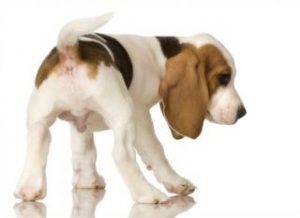Why do some dogs have trouble with their anal sacs?
Occasionally, anal sacs become a medical problem. There is no specific breed, color or size that is predisposed to problems of the anal sacs. For no apparent reason, some pets have a problem and some do not. Dogs are much more frequently affected than cats. As a consequence, they became very full or “impacted.”
Aft er one dog, Toby, turned 3 years old, his anal sacs were not expressing themselves, for some unknown reason. He needed routine veterinary visits to empty his anal sacs. Toby’s family vet was able to easily empty or “express” them manually. Initially, it was every few months. Then it became a weekly occurrence. Then it became a necessity every other day!
er one dog, Toby, turned 3 years old, his anal sacs were not expressing themselves, for some unknown reason. He needed routine veterinary visits to empty his anal sacs. Toby’s family vet was able to easily empty or “express” them manually. Initially, it was every few months. Then it became a weekly occurrence. Then it became a necessity every other day!
What if a dog needs more advanced anal sac treatment? For Toby, removing the anal sacs surgically was discussed. It was the only reasonable option at that point. It’s a delicate procedure, which poses a few risks:
- There is a small risk of infection. Although the area is thoroughly scrubbed before surgery, working near the anus is not exactly the most sterile procedure. In addition, the content of the anal sacs is filthy and full of bacteria.
- There is a small risk of future problems if the entire sac is not removed. Even if a tiny piece is left behind, it will cause a delayed infection that will lead to a draining tract. Pus and/or secretions will constantly ooze through a small hole in the skin near the anus. This will require a second surgery to remove the draining tract and the tissue causing the problem.
- There is also a small risk of incontinence. Continence, or the ability to control poop, is the opposite of incontinence. When a dog is incontinent, he defecates just about anywhere, without even being aware of it. Continence is controlled by a specialized muscle called the anal sphincter. In fact, there are two anal sphincters: one on the inside and one on the outside.
- Anal sacs are located between the external and internal sphincter muscles. So in order to remove an anal sac, there is no choice: we must cut into the sphincter, hence the risk of incontinence if the thin muscle is not sutured perfectly well at the end of the surgery.
If you have any questions or are looking to book an appointment with us in the Seymour/Deep Cove area of North Vancouver, come see us or give us a call at 604-929-1863!

